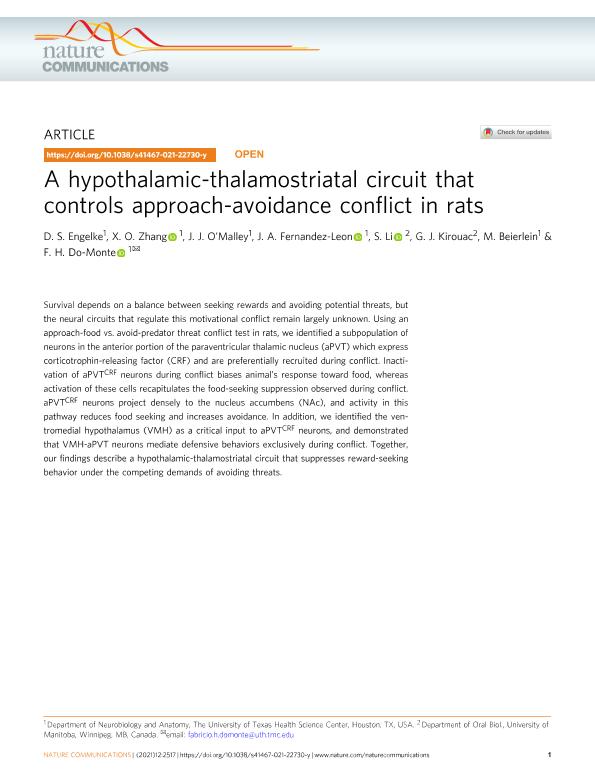Artículo
A hypothalamic-thalamostriatal circuit that controls approach-avoidance conflict in rats
Engelke, D. S.; Zhang, X. O.; O’Malley, J. J.; Fernandez Leon, Jose Alberto ; Li, S.; Kirouac, G. J.; Beierlein, M.; Do Monte, F. H.
; Li, S.; Kirouac, G. J.; Beierlein, M.; Do Monte, F. H.
 ; Li, S.; Kirouac, G. J.; Beierlein, M.; Do Monte, F. H.
; Li, S.; Kirouac, G. J.; Beierlein, M.; Do Monte, F. H.
Fecha de publicación:
05/2021
Editorial:
Nature
Revista:
Nature Communications
ISSN:
2041-1723
Idioma:
Inglés
Tipo de recurso:
Artículo publicado
Clasificación temática:
Resumen
Survival depends on a balance between seeking rewards and avoiding potential threats, but the neural circuits that regulate this motivational conflict remain largely unknown. Using an approach-food vs. avoid-predator threat conflict test in rats, we identified a subpopulation of neurons in the anterior portion of the paraventricular thalamic nucleus (aPVT) which express corticotrophin-releasing factor (CRF) and are preferentially recruited during conflict. Inactivation of aPVTCRF neurons during conflict biases animal’s response toward food, whereas activation of these cells recapitulates the food-seeking suppression observed during conflict. aPVTCRF neurons project densely to the nucleus accumbens (NAc), and activity in this pathway reduces food seeking and increases avoidance. In addition, we identified the ventromedial hypothalamus (VMH) as a critical input to aPVTCRF neurons, and demonstrated that VMH-aPVT neurons mediate defensive behaviors exclusively during conflict. Together, our findings describe a hypothalamic-thalamostriatal circuit that suppresses reward-seeking behavior under the competing demands of avoiding threats.
Palabras clave:
paraventricular thalamic nucleus
,
reward
,
avoidance
,
food seeking
Archivos asociados
Licencia
Identificadores
Colecciones
Articulos(CIFICEN)
Articulos de CENTRO DE INV. EN FISICA E INGENIERIA DEL CENTRO DE LA PCIA. DE BS. AS.
Articulos de CENTRO DE INV. EN FISICA E INGENIERIA DEL CENTRO DE LA PCIA. DE BS. AS.
Citación
Engelke, D. S.; Zhang, X. O.; O’Malley, J. J.; Fernandez Leon, Jose Alberto; Li, S.; et al.; A hypothalamic-thalamostriatal circuit that controls approach-avoidance conflict in rats; Nature; Nature Communications; 12; 1; 5-2021; 1-19
Compartir
Altmétricas



